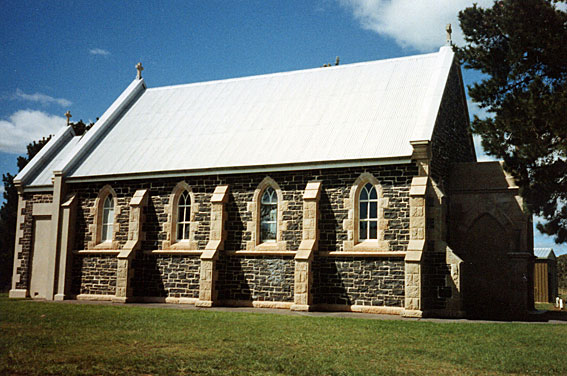
St Matthew's Anglican Church, Drayton
[Photograph by Howard Baker (1990s)]

St Matthew's Anglican Church, Drayton
[Photograph by Howard Baker (1990s)]
Historical and Technical Documentation by Geoffrey Cox
© OHTA 2011, 2013 (last updated May 2013)
Situated some six kilometres south of Toowoomba, Drayton is the oldest Anglican parish on the Darling Downs. Early settlers had moved to this fertile region from the late 1840s onwards, and Drayton was surveyed in 1849. It was initially the focal point for activity in the region, and remained so until Toowoomba became the centre of the Darling Downs in the late 1860s. The Revd Benjamin Glennie was appointed as Incumbent at Drayton in 1850, and the original church was opened in January 1859. This was a simple slab building on the corner of Cambooya and Rudd Streets.1
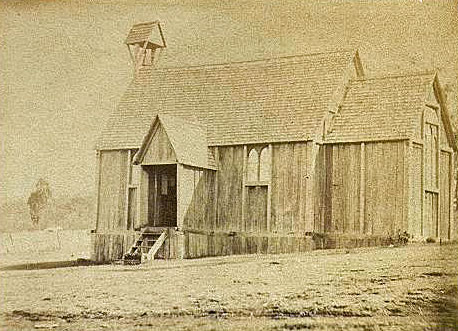
The original St Matthew's Church, Drayton, c.1870
[Photograph: Hume Family Collection,
Fryer Library, University of Queensland]
There was a harmonium in the original church, which was reported in 1866 by Mrs Katie Hume, a local resident, to be played by a storekeeper's daughter 'so that no one can sing to it, so hurried & such wrong notes!'2 Mrs Hume herself played the harmonium in the following year, and described the music in more detail:
... We have been to church this morning, when I performed at the Harmonium for the first time i.e. I played the Hymns. We had no chanting. Miss Favenc asked me thro' Mr. Clayton if I wd take alternate Sundays with her, so I have been practising. It is a poor little instrument. No stops. One cannot make much of it. I played 'Agnus Dei from Mozart's 1st. I long to hear yr beautiful Easter Music, & to join in yr hearty Services. People are sadly indifferent to such matters here. The affairs of this world seem to absorb all their time & attention.3
The present bluestone church, designed by the distinguished local architect, James Marks, was dedicated in December 1887. It originally had a temporary timber chancel, which was replaced in bluestone between 1933 and 1935.4
The pipe organ arrived in the present church only in 1976, but it has a history that can be traced back much earlier. This instrument was built by Leslie W. Rub of Toowoomba, who had worked on pipe organs in the region over many years in association with Walter Emerson. It was dedicated by Bishop Ralph Wicks on 31 October 1976 at a recital played by Graeme Morton of Brisbane, along with the boys' choir of the Toowoomba Preparatory School directed by Walter Emerson and Toowoomba contralto, Margaret Proellocks.5
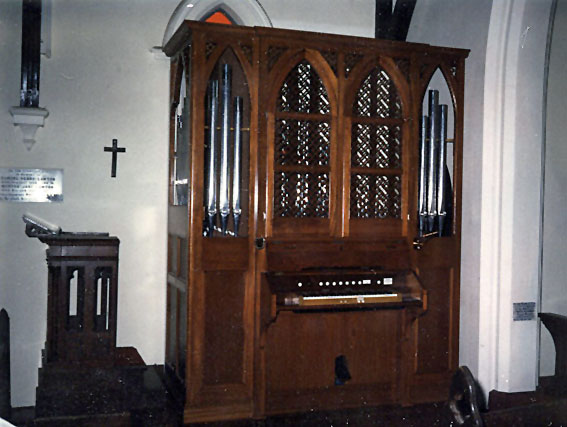
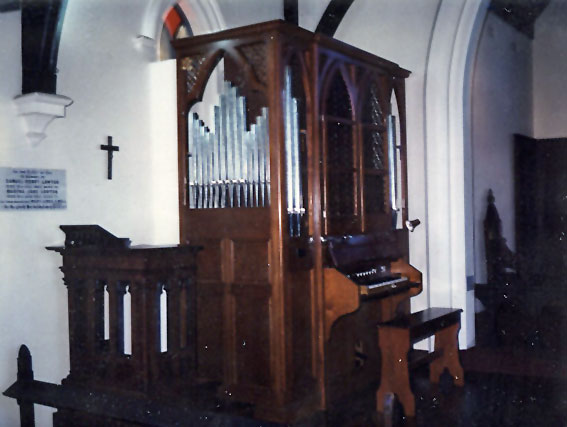
The 1976 organ in St Matthew's, Drayton
(before the addition of pedals)
[Photographs by Les Rub (c.1976)]
This organ has a degree of historic significance in that it incorporates restored parts of the B.B. Whitehouse & Co. organ built in 1909 for the Presbyterian Church, Toowong and transferred to the Uniting (formerly Methodist) Church, Toowong, in 1959. This was one of several single-manual mechanical-action instruments built by the firm around this time, all using divided stops to a greater or lesser extent.6
The parts of the Toowong instrument preserved at Drayton are the console, soundboard and action, the building frame, the swell box, and the bottom octave of the present Rohr Gedackt rank. The 58-note Whitehouse soundboard from Toowong included three divided stops (at e' / f'), and this feature is retained in the present instrument.
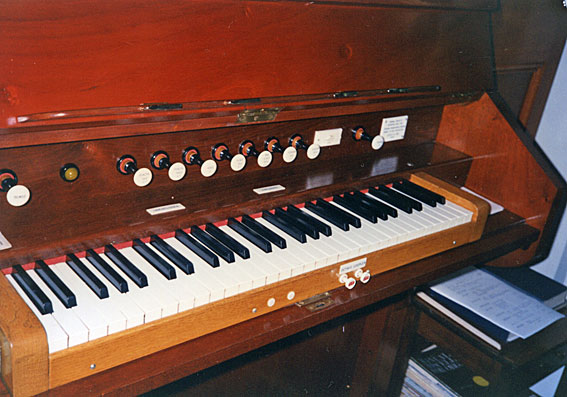
The console of the 1909 B.B. Whitehouse & Co organ
with minor modifications
[Photograph by Howard Baker (1990s)]
The casework, bellows, blower and most of the manual pipework were added in 1976. The Gamba 8ft came secondhand from St Paul's Lutheran Church, Toowoomba, where it had been a Vox Celeste, while the remaining pipework was obtained new from Aug. Laukhuff in Germany. All of the manual pipework is enclosed apart from the Principal 4ft, the bottom 19 pipes of which comprise the display pipes on pneumatic action.7
The Toowong instrument originally included pedals, although these were not incorporated into the 1976 instrument at Drayton. The present pedalboard and Bourdon 16ft were added to the organ in 1984 using direct electric action. They originated from a redundant S.T. Noad organ in Sydney, and were obtained by Les Rub from Ian D. Brown & Associates of Ballina.8
| MANUAL Rohr Gedackt Bass Rohr Gedackt Treble Gamba Principal Bass Principal Treble Gemshorn Bass Gemshorn Treble PEDAL Bourdon COUPLERS Octave Coupler [Manual to Pedal] |
8 8 8 4 4 2 2 16 |
(gvd bass) [1984] (thumb pistons) [1984] |
Tremolo (draw-stop)
Drawstop console
Balanced swell pedal (formerly lever swell)
Mechanical action (manual), except for show pipes & direct electric action (pedal)
Compass: 58/30.9
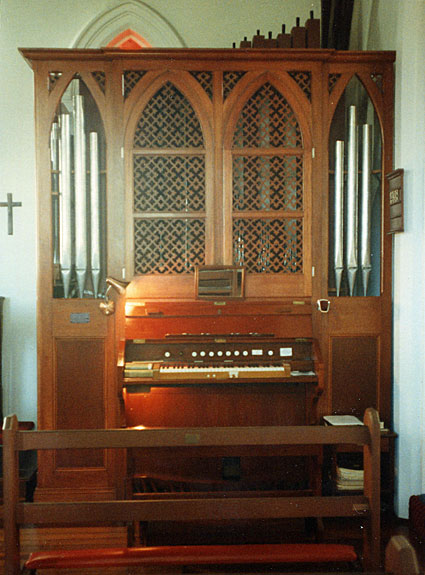
The 1976 organ in St Matthew's, Drayton
(after the addition of pedals in 1984)
[Photograph by Howard Baker (1990s)]
_______________________________________________________________________
1 Queensland Heritage Council, Queensland Heritage Register, locations 600837 (St Matthew's, Drayton) & 601878 (St Luke's, Toowoomba).
2 Bonnin, Nancy, ed. Katie Hume on the Darling Downs: A Colonial Marriage (Toowoomba: Darling Downs Institute Press, 1985), p. 31.
3 Bonnin, p. 58.
4 Queensland Heritage Council, Queensland Heritage Register, location 600837; Donald Watson & Judith McKay, Queensland Architects of the 19th Century: A Biographical Dictionary (Brisbane: Queensland Museum, 1994), pp. 121-22.
5 Organ Dedication Programme (31 October 1976), supplied by Leslie W. Rub.
6 Other similar instruments were those at the Presbyterian Church, Ithaca (1905), the Methodist Church, Warwick (1909), the Methodist Church, Wooloowin (1911) and the Scots Church, Clayfield (1907). Of these, only the Ithaca instrument, now at St Margaret's Anglican Girls' School, Ascot, and the Scots Church instrument, now at St Alban's Anglican Church, Toowoomba, remain relatively intact.
7 Personal communication to G. Cox from Leslie W. Rub, January 1978.
8 Personal communications to G. Cox from Leslie W. Rub, March 1987 & June 2003.
9 Personal communications to G. Cox from Leslie W. Rub, January 1978 & June 2003.